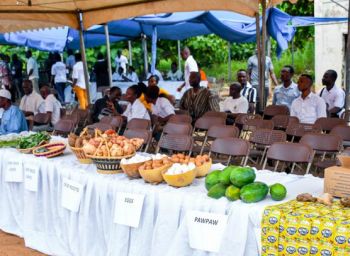Evaluation of the Improved Feeding Practices for the First 1000 Days Project in Ghana
Abstract
Background
Sub-optimal nutrition during the first 1000 days of life can impair the physical and
cognitive development of children, as well as limit their health and wellbeing. The
improved feeding practices for the first 1,000 days (IFP) project aimed to improve the
dietary practices of women of reproductive age (pregnant and lactating) and children below
ages two years in three selected districts (Kassena-Nankana West [KNW], Sekyere East[SE],
and Kintampo South[KS]) in Ghana. This integrated project combined interventions on
micronutrient powder (MNP) distribution, social behaviour-change communication, and
nutrition-sensitive agriculture to catalyse enhanced awareness and consumption of
nutrient-rich foods in selected communities.
Objective
This paper evaluates the IFP project based on measures associated with relevance,
effectiveness, impact, and sustainability.
Methods
Using a mixed-methods design, data from in-depth interviews of project beneficiaries, and
key community-based actors involved in the project’s implementation were triangulated
with routine project monitoring data, and documentation to answer the evaluation
questions. The evaluation questions and our analyses were guided by the Development
Assistance Committee evaluation criteria. Interviews with key stakeholders were
conducted in June 2023. Key project data were compared between baseline and endline
assessments to ascertain the extent to which the project met its intended objectives and
targets.
Results
The project demonstrated high relevance of the proposed project among the target groups;
for example, nearly half the children were eating low quality, non-diverse diets (49% in
KNW, 46% in KS and 35 in SE). The project enabled almost 14,000 children to be reached
with MNP. While 96,000 eggs were produced, <10% was consumed at home. About 35,000
kilograms of orange-fleshed sweet potatoes (OFSP) were produced, resulting in improved
access to the nutrient-rich foods produced. Nutrition messages were disseminated widely
and were reported to have contributed to improved awareness of nutrition among
caregivers. Data-based and reported evidence both indicated there was improved child
dietary diversity between baseline and endline of the project; in KNW, 90% of children met
minimum dietary diversity at endline compared to 75% at baseline. In KS and SE, the
endline estimates of dietary diversity were 71% and 70%, up from 65% in both districts at
baseline, respectively. Multiple strategies aiming to support project sustainability that
were built into the project design were implemented. Additional sustainability strategies
evolved during the project’s lifetime, including crossbreeding of project chickens with
hardier local breeds, continued multiplication of OFSP vines, and transfer of Village
Savings and Loans Association funds accumulated from MNP sale to Village-Based
Entrepreneurs to sustain MNP supply.
Conclusions
IFP project delivered interventions successfully, leading to improved awareness and
practices related to diets of women in reproductive age and young children, in project
communities. These strategies can be extended to women and children living in similar
settings to improve the diet quality of women and children.

Authors retain all copyrights. In making a submission to World Nutrition, they are certifying that all material is theirs except quotations, as indicated, and that they have obtained permission for any photos, tables, or graphics taken from other publications or websites.




